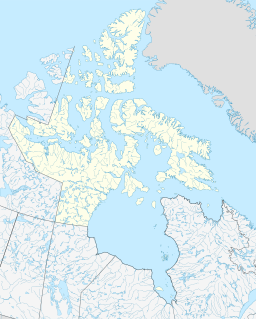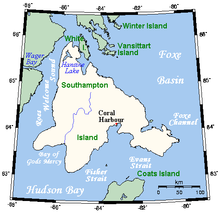| Native Bay | |
|---|---|
 | |
| Location | Hudson Bay |
| Coordinates | 63°52′N 82°38′W / 63.867°N 82.633°W / 63.867; -82.633 (Native Bay) |
| Ocean/sea sources | Arctic Ocean |
| Basin countries | Canada |
| Settlements | Uninhabited |
Native Bay is a waterway in the Kivalliq Region, Nunavut, Canada. It is located in Hudson Bay off western Southampton Island. The Bell Peninsula lies to the southeast. Native Point is located at the bay's southern tip. East Bay is 20 km (12 mi) to the east and Coral Harbour is 36 km (22 mi) to the north northwest.
Geography
The habitat consists of three main types, water, unvegetated land, and moist or wet vegetated tundra. This can be further broken down as dry heath, gravel ridge, intertidal zone, moss carpet, scrub willow, and sedge meadow. The elevation rises up to 122 m (400 ft) above sea level.
Climate

Southampton Island has a severe subarctic climate (Köppen Dfc) which transitions into a tundra climate (ET). Like almost all of Nunavut, Southampton Island is entirely above the tree line. Coral Harbour has never gone above freezing in January, February and March (although the latter has recorded 0.0 °C (32.0 °F). Due to the frozen nature of Hudson Bay, there is a severe seasonal lag until June, especially compared to more continental areas such as Fairbanks despite much sunshine and perpetual twilight at night. Due to the drop of solar strength and the absence of warm water even in summer, temperatures still drop off very fast as September approaches. Cold extremes are severe, but in line with many areas even farther south in Canada's interior.
| Climate data for Coral Harbour (Coral Harbour Airport) WMO ID: 71915; coordinates 64°11′36″N 83°21′34″W / 64.19333°N 83.35944°W / 64.19333; -83.35944 (Coral Harbour Airport); elevation: 62.2 m (204 ft); 1991–2020 normals, extremes 1933−present | |||||||||||||
|---|---|---|---|---|---|---|---|---|---|---|---|---|---|
| Month | Jan | Feb | Mar | Apr | May | Jun | Jul | Aug | Sep | Oct | Nov | Dec | Year |
| Record high humidex | 0.2 | −1.9 | −0.5 | 4.4 | 8.9 | 23.1 | 32.8 | 30.1 | 19.9 | 7.6 | 3.7 | 3.2 | 32.8 |
| Record high °C (°F) | 0.6 (33.1) |
−1.1 (30.0) |
0.0 (32.0) |
5.0 (41.0) |
9.4 (48.9) |
23.5 (74.3) |
28.0 (82.4) |
26.1 (79.0) |
18.5 (65.3) |
7.6 (45.7) |
4.0 (39.2) |
3.4 (38.1) |
28.0 (82.4) |
| Mean daily maximum °C (°F) | −24.9 (−12.8) |
−25.6 (−14.1) |
−20.2 (−4.4) |
−11.0 (12.2) |
−2.5 (27.5) |
6.9 (44.4) |
14.8 (58.6) |
12.1 (53.8) |
4.8 (40.6) |
−2.5 (27.5) |
−11.2 (11.8) |
−19.2 (−2.6) |
−6.5 (20.3) |
| Daily mean °C (°F) | −29.0 (−20.2) |
−29.7 (−21.5) |
−24.9 (−12.8) |
−16.1 (3.0) |
−6.0 (21.2) |
3.5 (38.3) |
10.2 (50.4) |
8.2 (46.8) |
2.0 (35.6) |
−5.5 (22.1) |
−15.5 (4.1) |
−23.4 (−10.1) |
−10.5 (13.1) |
| Mean daily minimum °C (°F) | −33.2 (−27.8) |
−33.7 (−28.7) |
−29.7 (−21.5) |
−21.1 (−6.0) |
−9.6 (14.7) |
0.1 (32.2) |
5.6 (42.1) |
4.2 (39.6) |
−0.8 (30.6) |
−8.6 (16.5) |
−19.8 (−3.6) |
−27.6 (−17.7) |
−14.5 (5.9) |
| Record low °C (°F) | −52.8 (−63.0) |
−51.4 (−60.5) |
−49.4 (−56.9) |
−39.4 (−38.9) |
−31.1 (−24.0) |
−15.6 (3.9) |
−1.1 (30.0) |
−3.3 (26.1) |
−17.2 (1.0) |
−34.4 (−29.9) |
−40.6 (−41.1) |
−48.9 (−56.0) |
−52.8 (−63.0) |
| Record low wind chill | −69.5 | −69.3 | −64.3 | −55.1 | −39.7 | −23.2 | −8.2 | −11.8 | −23.7 | −43.7 | −54.8 | −64.2 | −69.5 |
| Average precipitation mm (inches) | 9.5 (0.37) |
7.0 (0.28) |
11.2 (0.44) |
18.2 (0.72) |
19.0 (0.75) |
27.6 (1.09) |
34.1 (1.34) |
59.4 (2.34) |
45.4 (1.79) |
33.8 (1.33) |
22.9 (0.90) |
14.8 (0.58) |
302.9 (11.93) |
| Average rainfall mm (inches) | 0.0 (0.0) |
0.0 (0.0) |
0.0 (0.0) |
0.4 (0.02) |
4.3 (0.17) |
20.8 (0.82) |
34.1 (1.34) |
58.9 (2.32) |
36.7 (1.44) |
7.2 (0.28) |
0.5 (0.02) |
0.0 (0.0) |
163.0 (6.42) |
| Average snowfall cm (inches) | 9.6 (3.8) |
7.1 (2.8) |
11.3 (4.4) |
18.2 (7.2) |
14.9 (5.9) |
6.9 (2.7) |
0.0 (0.0) |
0.6 (0.2) |
8.6 (3.4) |
26.7 (10.5) |
22.9 (9.0) |
14.8 (5.8) |
141.6 (55.7) |
| Average precipitation days (≥ 0.2 mm) | 8.5 | 6.7 | 9.0 | 9.5 | 10.4 | 9.6 | 9.6 | 12.6 | 11.2 | 14.6 | 13.0 | 10.4 | 125.1 |
| Average rainy days (≥ 0.2 mm) | 0.0 | 0.0 | 0.0 | 0.2 | 1.8 | 7.2 | 9.6 | 12.5 | 8.2 | 3.6 | 0.6 | 0.1 | 43.8 |
| Average snowy days (≥ 0.2 cm) | 8.6 | 6.6 | 9.0 | 9.5 | 9.4 | 3.3 | 0.0 | 0.3 | 4.3 | 13.1 | 12.9 | 10.4 | 87.3 |
| Average relative humidity (%) (at 1500 LST) | 67.4 | 66.4 | 69.2 | 74.5 | 80.3 | 73.1 | 62.8 | 69.1 | 75.8 | 85.5 | 79.7 | 72.0 | 73.0 |
| Mean monthly sunshine hours | 37.9 | 112.1 | 187.4 | 240.2 | 239.9 | 262.2 | 312.3 | 220.4 | 109.8 | 70.8 | 47.9 | 18.8 | 1,859.7 |
| Percent possible sunshine | 22.4 | 47.0 | 51.6 | 53.2 | 42.0 | 41.9 | 51.2 | 43.3 | 27.9 | 23.3 | 24.3 | 13.9 | 36.8 |
| Source: Environment and Climate Change Canada (rain/rain days, snow/snow days, precipitation/precipitation days and sun 1981–2010) | |||||||||||||
Fauna
East Bay/Native Bay is a Canadian Important Bird Area (#NU023) and lies just outside of the East Bay Migratory Bird Sanctuary. Notable bird species include Atlantic brant, colonial water birds, seabirds, common eider, and lesser snow goose.
Caribou frequent the area.
History
An archeological site exists on the west side of Native Point, the largest Sallirmiut site on the island.
Notes
- "Native Bay". Geographical Names Data Base. Natural Resources Canada. 27 May 2024.
- "Southampton Island". oceandots.com. Archived from the original on 23 December 2010. Retrieved 5 May 2009.
- "Point-to-point distance Native Bay – Coral Harbour". Natural Resources Canada. 16 February 2021. Retrieved 27 May 2024.
- ECCC 2020, p. 11.
- Pickavance, J.R. (September 2006). "The Spiders of East Bay, Southampton Island, Nunavut, Canada". Arctic. 59 (3): 278. doi:10.14430/arctic313.
- ECCC 2020, p. 2.
- "Coral Harbour Nunavut". Canadian Climate Normals 1991–2020. Environment and Climate Change Canada. Archived from the original on 10 July 2024. Retrieved 10 July 2024.
- "Coral Harbour A". Canadian Climate Normals 1981–2010. Environment and Climate Change Canada. Climate ID: 2301000. Archived from the original on 10 July 2024. Retrieved 24 January 2019.
- ^ "East Bay/Native Bay". bsc-eoc.org. Archived from the original on 12 June 2011. Retrieved 5 May 2009.
- "History". edu.nu.ca. Retrieved 5 May 2009.
References
- Qaqsauqtuuq Migratory Bird Sanctuary Management Plan (PDF) (Report). Environment and Climate Change Canada. 2020. Retrieved 23 May 2024.